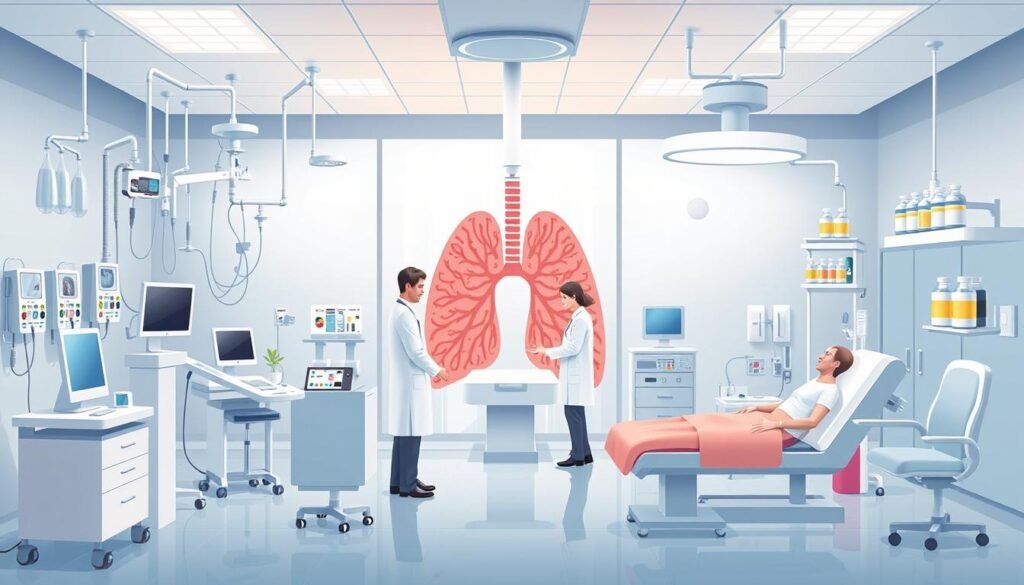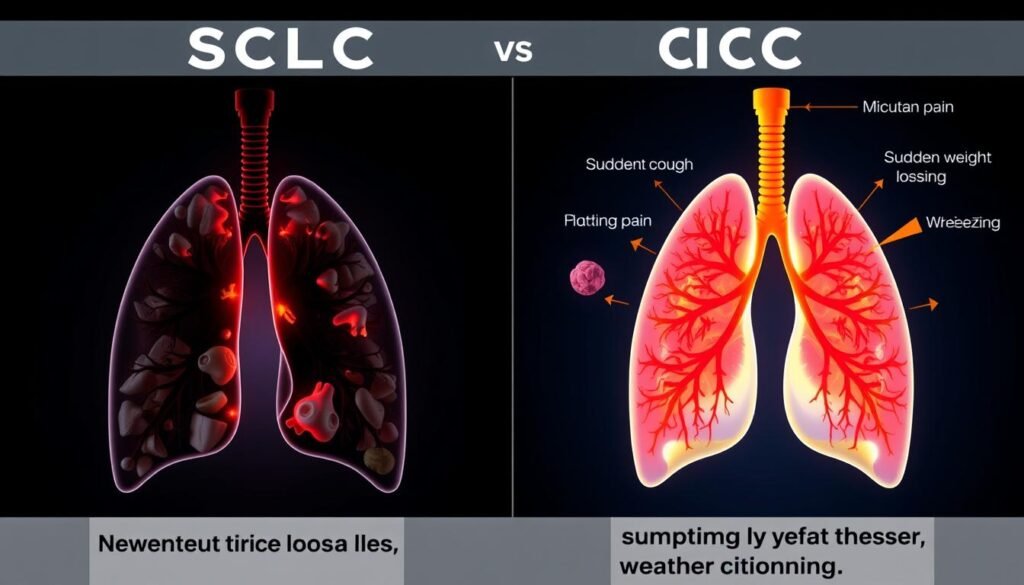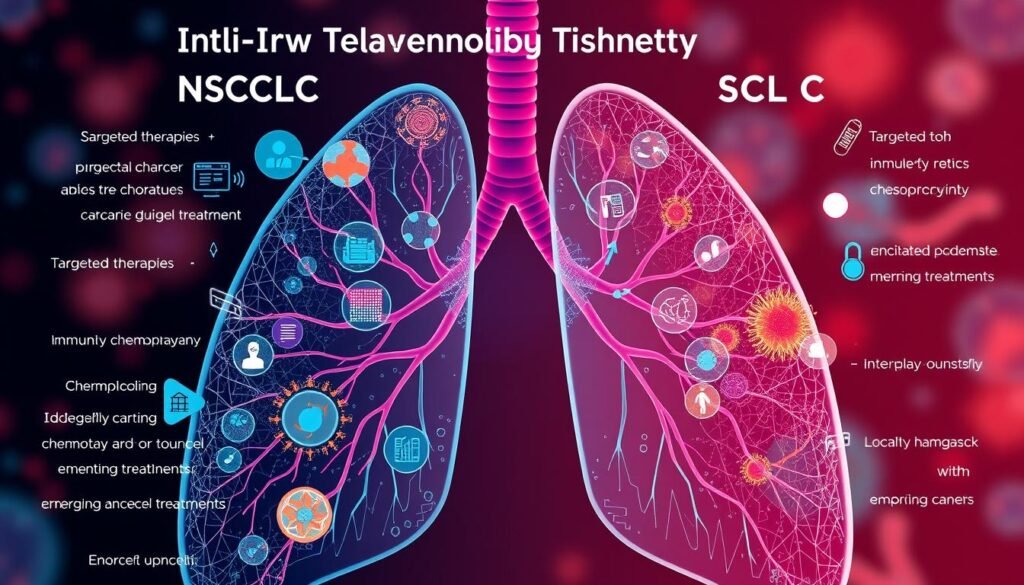Did you know Non-Small Cell Lung Cancer (NSCLC) makes up about 90% of all lung cancer cases? On the other hand, Small Cell Lung Cancer (SCLC) accounts for less than 20%. It’s key to know the big differences between these types for better patient care and lung cancer awareness.
Lung cancer is the top cause of cancer deaths for both men and women in the U.S. NSCLC and SCLC differ greatly in diagnosis, treatment options, growth rates, and symptoms. We will dive into these differences. Understanding them is crucial not just for doctors but also for patients and their families navigating these conditions.
Key Takeaways
- NSCLC accounts for nearly 90% of lung cancer diagnoses.
- SCLC represents fewer than 20% of lung cancer cases.
- Understanding the differences is key for effective treatment.
- Both types have unique symptoms and risk factors.
- Early detection can significantly improve survival rates.
Introduction to Lung Cancer Types
Lung cancer types fall into two main categories: Non-Small Cell Lung Cancer (NSCLC) and Small Cell Lung Cancer (SCLC). NSCLC makes up about 80% to 85% of all cases. SCLC, on the other hand, accounts for 10% to 15%. Knowing these groups helps us understand cancer better and make smart choices about treatment.
NSCLC includes subtypes like adenocarcinoma, squamous cell carcinoma, and large cell carcinoma. Adenocarcinoma is the most common, especially in women. Squamous cell carcinoma often links to smoking. This shows why it’s important to know the risks that come with smoking.
SCLC grows quickly and tends to spread early. Often, doctors find it after it has spread beyond the lungs. This difference between SCLC and NSCLC underlines the need for early screening and prevention.
Lung carcinoid tumors are less common, making up fewer than 5% of lung tumors. They grow slower than NSCLC and SCLC. Note that cancers starting in other organs can spread to the lungs but aren’t called lung cancer. Each type needs its own treatment plan, making the right diagnosis crucial.
What is Non-Small Cell Lung Cancer (NSCLC)?
Non-small cell lung cancer, also known as NSCLC, makes up about 80% of all lung cancer cases. It includes different types like adenocarcinoma, squamous cell carcinoma, and large cell carcinoma. These types have unique signs and affect treatment choices.
Adenocarcinoma is found in about 40% of NSCLC cases. It starts in the mucus-making cells inside lung air passages. This type is common in non-smokers and usually appears in the lungs’ outer areas. Squamous cell carcinoma, on the other hand, forms in the central parts of the lungs. It’s linked to smoking and makes up about one-third of NSCLC.
Large cell carcinoma affects around 10% of people with NSCLC. It can grow anywhere in the lung. Due to its fast growth, spotting it early is crucial. Often, NSCLC is slow to progress. This means it might not get noticed until it’s more advanced, affecting treatments and results.
Knowing about the different NSCLC types helps doctors decide on treatments. It also affects how well treatments might work. Nowadays, research in lung cancer is focused on finding better treatment methods. This could mean better results for people with these types of lung cancer.
| NSCLC Types | Prevalence in NSCLC Cases | Characteristics |
|---|---|---|
| Adenocarcinoma | ~40% | Most common subtype, often found in non-smokers, peripheral lung regions |
| Squamous Cell Carcinoma | ~30% | Associated with smoking, typically arises in central lung areas |
| Large Cell Carcinoma | ~10% | Rapid growth, can occur anywhere in the lungs |
What is Small Cell Lung Cancer (SCLC)?
Small cell lung cancer (SCLC) is a main type of lung cancer, making up about 10 to 15% of all cases. It is known for small, round cells that grow fast, making it a very aggressive lung cancer. SCLC is divided into small cell carcinoma and combined small cell carcinoma, with elements of non-small cell lung cancer (NSCLC).
SCLC grows quickly and often spreads early, which means it’s usually found at advanced stages. This makes treatment difficult and lowers chances of survival. In fact, the survival rate after 5 years is only around 7%. Finding it early is key, especially for those at high risk.
Nearly all SCLC patients, about 95%, have smoked before. Stopping smoking can cut your death risk in half if SCLC is caught early. This shows how critical regular screenings are, as the disease can worsen fast without treatment.
Genetics play a big role in the risk of lung cancer, affecting both risk and treatment. Personalized treatment plans, especially at cancer centers, are essential. For more info on small cell vs. non-small cell lung cancer, see this resource. Also, check out this link for more on genetics and lung cancer risk.
| Characteristic | SCLC | NSCLC |
|---|---|---|
| Proportion of Lung Cancer Cases | 10-15% | 85%+ |
| Cell Size | Small, round cells | Larger, diverse cell types |
| Growth Rate | Very rapid | Slower, varies by subtype |
| Metastasis | Frequent and fast | Less common, varies |
| 5-Year Survival Rate | 7% (overall) | 63% (localized cases) |
Key Differences Between NSCLC and SCLC in Diagnosis and Treatment
It’s essential to know the differences in diagnosing and treating non-small cell lung cancer (NSCLC) and small cell lung cancer (SCLC) for better patient care. The methods to diagnose and options to treat these cancers vary a lot. This knowledge leads to more effective management of patients.
Understanding Diagnosis Methods for NSCLC
Diagnosing NSCLC usually combines imaging techniques like chest X-rays and CT scans. Suspicious areas lead doctors to perform biopsies, checking for cancer cells. This might result in a later diagnosis, as NSCLC grows slowly.
NSCLC makes up about 85% of lung cancer cases. Catching it early helps in treating it better.
Understanding Diagnosis Methods for SCLC
SCLC diagnosis often happens at advanced stages because it’s very aggressive. CT scans are also crucial for SCLC diagnosis. Its fast growth means patients often have widespread cancer at diagnosis.
SCLC represents around 15% of lung cancer cases. Recognizing its rapid progression is key for effective treatment.
| Aspect | NSCLC Diagnosis | SCLC Diagnosis |
|---|---|---|
| Prevalence | About 85% of lung cancer cases | About 15% of lung cancer cases |
| Growth Rate | Slower growing | Quickly grows and spreads |
| Diagnosis Stage | Often diagnosed at a later stage | Frequently diagnosed at an advanced stage |
| Common Imaging | Chest X-rays, CT scans | Chest X-rays, CT scans |
| Biopsy Techniques | Typically requires tissue analysis | Requires tissue analysis for confirmation |
Understanding the differences in diagnosing NSCLC and SCLC is crucial for lung cancer treatment. It lets healthcare professionals choose the best treatments. It leads to improved care for patients.
Treatment Options for NSCLC
Non-small cell lung cancer (NSCLC) is most lung cancer cases. It has different NSCLC treatment options based on the cancer stage. For those in early stages, surgery is key, aiming to remove the tumor. This is mainly for stages I, II, and IIIA.
For later stages, like stage IV, the plan often includes chemotherapy, targeted therapies, and sometimes radiation. Radiation is used when surgery isn’t an option because the cancer has spread. The goal of chemotherapy here is to manage symptoms and may extend life.
Surgery could cure early-stage NSCLC. But, adjuvant treatments like chemotherapy help reduce relapse risks. In cases of locally advanced NSCLC, combining chemotherapy with radiation therapy improves disease control. This can lead to better survival rates.
| Treatment Stage | Treatment Options |
|---|---|
| Stage I | Surgery, Stereotactic body radiation therapy (SBRT) |
| Stage II | Surgery, Chemotherapy (adjuvant) |
| Stage III | Surgery followed by Chemotherapy, Radiation therapy and Chemotherapy |
| Stage IV | Palliative Chemotherapy, Targeted therapies, Immunotherapy, Radiation therapy |
New treatments, especially immunotherapy, are promising for advanced NSCLC. These treatments are changing care options. For current treatment details, check out NSCLC treatment options from cancer.gov.
Treatment Options for SCLC
Small Cell Lung Cancer (SCLC) requires quick and strong treatment due to its rapid spread and high chance of coming back. Treatment mainly uses chemotherapy and radiation therapy. These are key in managing SCLC. About 30% of patients have tumors that haven’t spread beyond a certain area. Starting treatment early can lead to better results.
Prophylactic cranial radiation is also a common treatment for SCLC. It helps increase survival rates for those who’ve responded well to initial treatments. Thoracic radiation therapy can also improve long-term survival chances.
Despite these efforts, the overall outlook for SCLC patients can be grim. Only 5% to 10% live for five years after diagnosis. Those found in the early stages have a median survival time of 16 to 24 months. This includes a 5-year survival rate of up to 14%. Those with more advanced SCLC have a median survival time of just 6 to 12 months after treatment.
Continuous check-ups and treatment adjustments are key, as SCLC often returns. Clinical trials are exploring new combinations of treatments. They offer hope for better ways to fight this tough cancer. Research is crucial in finding more effective treatments for SCLC.
For more information on lung cancer treatments, including how to prevent it and specific advice, visit here.

Growth and Spread of NSCLC vs. SCLC
Non-small cell lung cancer (NSCLC) and small cell lung cancer (SCLC) grow and spread differently. It’s crucial to know these differences for treatment and managing outcomes.
Speed of Growth in NSCLC
NSCLC tends to grow slower than SCLC. Many NSCLC cases go unnoticed early on, staying symptom-free for a while. The common type, adenocarcinoma, often affects non-smokers and progresses slowly. About 25% of NSCLC patients find out they have it early, which helps in treating it successfully. This slow growth allows for various treatments, including diet improvements during therapy.
Good nutrition can help enhance treatment and support recovery. Patients should talk to their doctors about diet plans along with their treatment. Helpful information can be found at supporting health through nutrition.
Speed of Growth in SCLC
SCLC grows much faster than NSCLC. It quickly spreads to places like the brain and liver. While it makes up less than 20% of lung cancer cases, it’s very challenging. This is because it spreads fast, often before symptoms are noticed.
Due to its rapid spread, treatments like preventative brain radiation are considered early. About 25% of SCLC patients can see remission with chemotherapy and radiation. Knowing the difference in how fast they grow helps doctors choose the best treatment.
Symptoms of NSCLC and SCLC
Lung cancer symptoms differ, but NSCLC and SCLC share several signs. Patients often report:
- Persistent cough
- Chest discomfort
- Unexplained weight loss
- Fatigue
NSCLC symptoms might not be clear at first. On the other hand, SCLC symptoms can be more severe as the disease grows. SCLC’s aggressive nature means symptoms like metastasis can show up earlier than in NSCLC. These may include:
- Bone pain
- Neurological changes, such as seizures
Knowing these symptoms is critical for early detection. This can greatly affect treatment success. Being aware of how NSCLC and SCLC differ can help in getting early treatment. This might improve chances of survival for those facing these tough conditions.

Risk Factors Associated with NSCLC and SCLC
Lung cancer risk factors greatly impact the chance of getting NSCLC and SCLC. Smoking is the biggest cause, linked to around 80% of lung cancer deaths. It’s especially risky for SCLC. Knowing these risks helps with prevention and early detection.
Here are the main risk factors for lung cancer:
- Smoking: This is the top risk. Smokers are much more likely to get lung cancer than non-smokers.
- Secondhand Smoke: It causes about 1.6% of lung cancer cases, making it a serious risk.
- Radon Exposure: As the second major cause of lung cancer in the U.S., radon is harmful, especially to non-smokers.
- Occupational Hazards: Being around asbestos, silica dust, and other harmful substances at work can increase lung cancer risk.
- Radiation Therapy: People who’ve had chest radiation for other cancers may be more likely to get lung cancer.
- Genetic Factors: Family lung cancer history and certain genes might increase someone’s risk.
- Environmental Pollution: Pollution from things like diesel exhaust contributes to some lung cancer deaths.
| Risk Factor | Type of Cancer Impacted | % Contribution to Lung Cancer |
|---|---|---|
| Smoking | SCLC, NSCLC | ~80% |
| Secondhand Smoke | SCLC, NSCLC | ~1.6% |
| Radon | Primarily NSCLC | ~10% |
| Occupational Exposures | NSCLC | Varies |
| Radiation Therapy | NSCLC | Increased Risk |
| Genetic Factors | NSCLC, SCLC | Varies |
| Environmental Pollution | NSCLC | ~1%-2% |
Knowing about these risks is key to lung cancer prevention. It lets people and doctors come up with ways to lower their risk. Understanding how smoking, the environment, and work exposures link to lung cancer is crucial in the fight against it.
Current Trends in Treatment Approaches
Treatment for lung cancer is quickly changing thanks to new research. Nowadays, treatments are designed based on a person’s genetic makeup and the specifics of their tumor. This kind of treatment, known as personalized medicine, is making therapies more effective. It’s especially useful for non-small cell lung cancer (NSCLC), which makes up about 85% of all lung cancer cases.
Immunotherapy has become a key part of lung cancer treatment. It boosts the body’s natural defenses to fight cancer. This has led to better survival rates for people with advanced NSCLC. There are now many FDA-approved treatments available. These include drugs that target specific parts of cancer cells, showing great results.
Clinical trials are essential for testing new treatments. They help us see how these treatments affect patients. Studies are ongoing to see how combining immunotherapy with other treatments can work. For example, using anti-VEGF therapy with chemotherapy has shown good results in advanced NSCLC.
The future of lung cancer treatment looks bright. More research will bring new treatments to patients. This will likely lead to better survival rates and improved quality of life for those with lung cancer.
| Treatment Approach | Type | Key Agents | Notable Outcomes |
|---|---|---|---|
| Targeted Therapy | NSCLC | Afatinib, Osimertinib | Progression-free survival up to 13.6 months |
| Immunotherapy | NSCLC & SCLC | Nivolumab, Pembrolizumab | Enhanced immune response and survival rates |
| Anti-VEGF Therapy | Advanced NSCLC | Bevacizumab, Ramucirumab | Improved efficacy in combination with chemotherapy |

Conclusion
It’s key to know the difference between non-small cell lung cancer (NSCLC) and small cell lung cancer (SCLC) for both patients and doctors. This summary of NSCLC and SCLC shows their unique traits, growth rates, and how they’re treated. For example, NSCLC makes up about 80% of lung cancer cases and has many treatment options. SCLC, on the other hand, accounts for 15% of cases and treatment usually includes chemotherapy with drugs like cisplatin or carboplatin and etoposide.
Research is always uncovering new things about lung cancer. This includes risk factors, how to tell the prognosis, and how combining treatments can help patients. Studies show that using beta-blockers with radiation therapy for NSCLC can improve how long patients live. Also, understanding how environmental factors affect people who’ve never smoked but get NSCLC is becoming crucial.
As research progresses, especially in detecting lung cancer early, we’ll see big advancements in how we tailor treatments to each patient. Ongoing studies on lung cancer will lead to better care and hope for those dealing with it. For more information and detailed studies on how surgeries and treatments vary at different stages of lung cancer, check out the recent studies here.